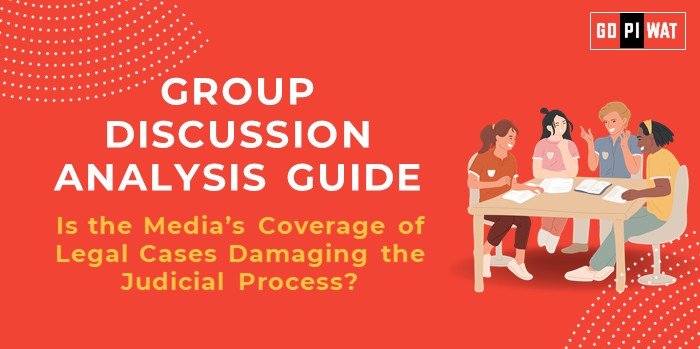📋 GD Analysis Guide: Is the Media’s Coverage of Legal Cases Damaging the Judicial Process?
🌐 Introduction to the Topic
Media coverage of high-profile legal cases often serves as a bridge between judicial proceedings and public awareness. However, concerns about sensationalism and trial by media challenge the integrity of the judicial process.
The media’s role as the “fourth estate” grants it immense influence, but it must balance public interest with the sanctity of judicial proceedings. Instances of prejudicial reporting have reignited debates about ethics and legal boundaries in journalism.
📊 Quick Facts and Key Statistics
🗓️ Global Trust in Media: Only 42% of global respondents trust media, reflecting concerns over sensationalism (Edelman Trust Barometer, 2023).
📋 Prejudicial Cases: 70% of legal experts believe media coverage affected public perception in cases like O.J. Simpson’s trial (Survey, 2022).
🌍 Indian Context: TRP-driven coverage of the Sushant Singh Rajput case raised ethical questions about media trials (Press Council of India Report, 2021).
📋 Prejudicial Cases: 70% of legal experts believe media coverage affected public perception in cases like O.J. Simpson’s trial (Survey, 2022).
🌍 Indian Context: TRP-driven coverage of the Sushant Singh Rajput case raised ethical questions about media trials (Press Council of India Report, 2021).
👥 Stakeholders and Their Roles
- ⚖️ Judiciary: Upholds the rule of law and ensures fair trials.
- 📰 Media Houses: Responsible for accurate and unbiased reporting.
- 👨👩👧👦 Public: Seeks accountability and transparency from judicial institutions.
- 🔍 Regulatory Bodies: Ensure ethical journalism standards, e.g., PCI and NBSA in India.
🏆 Achievements and Challenges
✨ Achievements
- 🏅 Public Awareness: High-profile cases like Nirbhaya’s trial galvanized societal reform.
- 📈 Judicial Accountability: Media exposure has pressured timely judicial actions.
- 🌐 Information Accessibility: Digital platforms democratized access to case updates.
⚠️ Challenges
- ❌ Prejudicial Public Opinion: Sensationalism undermines presumption of innocence.
- 🔒 Media Overreach: Coverage sometimes reveals sensitive case details, endangering fair trials.
- 🌍 Global Comparison: While countries like the UK limit pre-trial publicity under contempt laws, enforcement in countries like India remains inconsistent.
💡 Structured Arguments for Discussion
- ✅ Supporting Stance: “Media ensures transparency and societal accountability in legal cases.”
- ❌ Opposing Stance: “Sensationalist media damages judicial neutrality, influencing verdicts.”
- ⚖️ Balanced Perspective: “While media fosters public awareness, regulatory oversight is needed to prevent prejudicial reporting.”
🎯 Effective Discussion Approaches
🔑 Opening Approaches
- 📊 Statistical Lead: “Studies show that 70% of citizens believe media influences verdicts in sensational cases.”
- 📚 Case-Based Opening: “The Rajat Gupta insider trading case highlights how media attention impacts legal proceedings.”
🛡️ Counter-Argument Handling
- 📋 Acknowledge Strengths: Media can highlight judicial inefficiencies.
- 🔍 Propose Solutions: Stress stricter regulations, like UK-style contempt laws.
🔍 Strategic Analysis of Strengths and Weaknesses
- 💪 Strengths: Promotes judicial accountability, enhances public awareness.
- ⚠️ Weaknesses: Encourages sensationalism, undermines due process.
- 🌱 Opportunities: Ethical journalism reforms, improved regulatory mechanisms.
- ⚡ Threats: Public trust erosion, judicial independence at risk.
📚 Connecting with B-School Applications
📝 Real-World Applications
- 📖 Research Theme: Study the impact of media trials on legal reforms.
- 🏢 Corporate Angle: Explore regulatory compliance as a CSR initiative.
📑 Sample Interview Questions
- 🧐 “Do you think media trials are a necessary evil?”
- 💬 “How can media ethics be enforced without stifling freedom of speech?”
🌟 Insights for B-School Students
- 📈 Understand how media coverage can shape public policy.
- 🤝 Evaluate ethical challenges in crisis communication and public relations.


